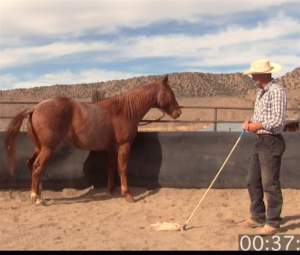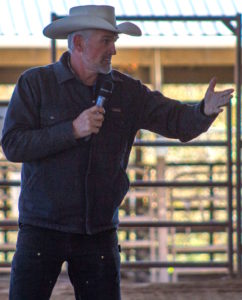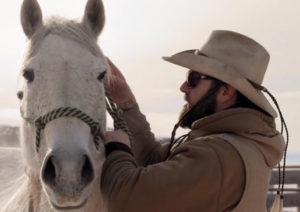No one’s doing a better job of connecting brain science with horsemanship in an innovative, easy-to-grasp, fashion than West Taylor.

West Taylor works with challenging horse
Recently, Taylor released this video of his work with a challenging horse from Colorado. Even by horsemanship video standards, “Flagging on the Fence: Downregulating a Nervous Horse” is long and protracted. But if you’re interested in seeing how a horse can change over the course of 90 minutes and in learning through the narration of Taylor’s science-supported commentary, it’s time well spent.
The video introduces a fun, new learning tool: the Dopamine Counter.
Read more about the neurochemical dopamine here.
At the beginning of the video, Taylor has the horse tied to a sturdy corral post with several feet of slack in the rope. The goal is to teach the mare to respond to his cue of tapping one side of her haunches or another, to move her hind end left or right.

West Taylor at the Best Horse Practices Summit
At first, it’s a struggle. Taylor taps her hind end repeatedly while clucking. Eventually and without much relaxation, she moves away from his pressure. Taylor responds by leaving her be and waiting. After several seconds, she lowers her head and licks and chews. Ding, ding, ding goes the Dopamine Counter.
If we were super nit-picky about the science, we could say the Dopamine Counter is a stretch. Of course, we don’t know that dopamine is being released in the brain at any precise moment. To do that, we’d have to have some pretty sophisticated equipment and serious expertise in that corral. But licking, chewing, and head lowering are generally associated with dopamine releases, says Dr. Steve Peters, a neuropsychologist at Intermountain Health and co-author of the book, Evidence-Based Horsemanship.
Taylor, owner of Wild West Mustang Ranch, has consulted extensively with Peters. Together, they have conducted Horse Brain Science Seminars. Typically, these offerings feature Peters’ academic presentations paired with Taylor’s work with horses in an arena.
We talked with Taylor about the mare’s progress through the video:
“At first, you can see that she’s barely finding the cue,” said Taylor. “She could barely complete my request, let alone calmly. I like to work toward a point where she is almost cueing herself. In the video, she’s headed there, for sure.”

Micah Fink, founder of Heroes and Horses
Taylor continues:
“Ultimately, what I want horses to do is relax within the cue (not just when the pressure is released). I like to work towards precision, without fear or too much energy. I want them to do something softly and confidently and to have calmness within the cue.”
Beginning next month, Taylor will start several mustangs for the Heroes and Horses. The Montana-based non-profit helps veterans reintegrate after their service by providing a free program in the Montana wilderness, teaching horsemanship, and optimizing the benefits of the horse-human connection.
The horses, all geldings, will come from the Bureau of Land Management facility in Axtel, Utah.